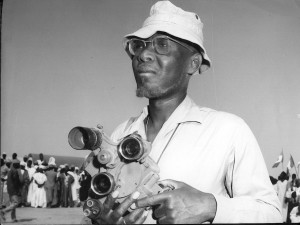Son histoire
Béninois de naissance et sénégalais d’adoption, Paulin Soumanou Vieyra est considéré comme le précurseur du cinéma africain. (né le 31 janvier 1925 à Porto-Novo, alors au Dahomey, aujourd’hui au Bénin et mort le 4 novembre 1987 à Paris, repose en paix au cimetière de Bel Air à Dakar au Sénégal)
 Réalisateur, critique, écrivain et historien, on lui doit une trentaine de documentaires et un seul long métrage, « En résidence surveillée ».
Réalisateur, critique, écrivain et historien, on lui doit une trentaine de documentaires et un seul long métrage, « En résidence surveillée ».
Premier Africain diplômé de l’Institut des Hautes Etudes Cinématographiques (IDHEC), aujourd’hui FEMIS, il tourne en 1955 Afrique-sur-Seine, film culte qui marque les débuts du cinéma africain.
À l’origine de la Fédération Panafricaine des Cinéastes (FEPACI) en 1969, il est reconnu comme le premier critique et le premier historien du cinéma africain avec la publication, en 1975, de « Le Cinéma africain : des origines à 1973 ».
Il est le mentor de grandes figures du septième art, telles que Ousmane Sembène, Djibril Diop Mambéty, Ababacar Samb Makharam.
L’origine de son nom de famille juif marane portugais, vient de son ancêtre Sébastien Sabino Vieyra dont le nom d’origine était Mama Gouyeh et qui fut d’abord déporté en esclavage du Nigeria, (royaume Yoruba, principauté de Bida), au Brésil, avant de revenir affranchi s’installer au Dahomey (actuel Bénin) aux environs de 1850. Les Africains affranchis portant des noms de leurs anciens maîtres portugais sont appelés les Agoudas au Bénin.
LIENS CLIQUABLES
Paulin Vieyra, Mutifaceted Pioneer (pdf)
Bulletin d’adhésion PSV-films et BCAT
PSV films in english
Paulin Soumanou Vieyra, the eldest of eight children, was born in Porto Novo, Benin (former Dahomey) on January 30, 1925. His great-grandfather, a Muslim Yorouba, was a member of a Bida royal family in Nigeria and was sent to Brazil as a slave. Following the 1835 Muslim slave rebellion in Bahia and emancipation in Brazil, Vieyra’s great-grandfather settled in the former Portuguese slave port of Porto Novo (New Port), which was said to be a tributary of the Yoruba kingdom of Oyo. He brought with him a mulatto wife, the daughter of his former Jewish Portuguese master and a black slave, as well as the Portuguese last name Vieyra. Paulin S. Vieyra’s father was a Yoruba railroad administrator. His mother, originally from Sierra Leone, was a merchant. In 1935, they sent Paulin, then 10 years old, to France to attend boarding school. In 1954, he graduated from IDHEC School with a thesis on cinema in French-speaking Africa. In 1955, Vieyra made history by directing the first substantial film by a French-speaking sub-Saharan African, Afrique sur Seine, 21-minute, 16mm black-and-white fiction film with Marpessa Dawn, star of Black Orpheus (1959). It was produced by the French Ministry of Cooperation, co-directed by aspiring filmmakers Jacques Melo Kane and Mamadou Sarr and shot by Robert Caristan. This quartet became known as « Le Groupe Africain de Cinema » (The African Cinema Group). Vieyra also served as a mentor and production director for Senegalese filmmakers including Sembene and Ababacar Samb Makaram and was a founding member of film institutions including The Pan-African Federation of Filmmakers (FEPACI) and the Pan-African Film Festival (FESPACO).
Samba Gadjigo

Inauguration le 26 février 2017
par Rémi Sagna Dircab du ministre de la culture du Sénégal
et Ardiouma Soma Délégué Général du FESPACO.
©PSV-Films 2021
.
